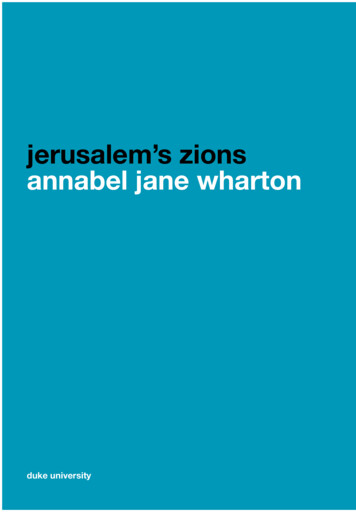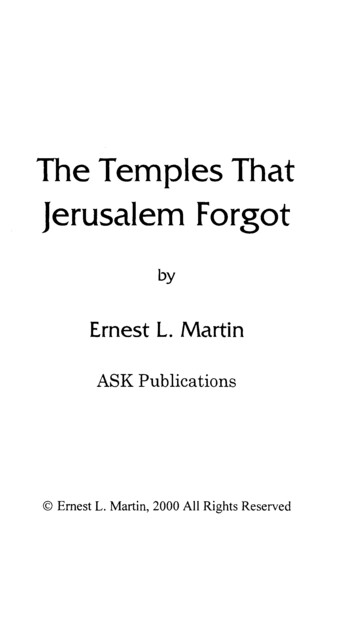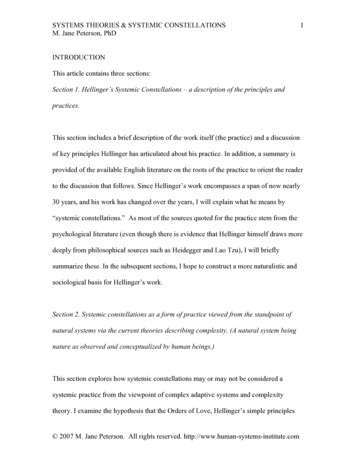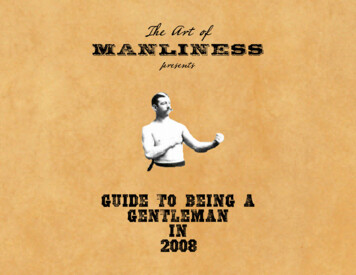
Transcription
218duke universityMaterial ReligionVolume 9Annabel Jane WhartonIssue 2Jerusalem’s ZionsAnnabel Jane Whartonjerusalem’s zionsannabel jane wharton
ABSTRACTThe human desire to embody the sacred, to give it aphysical place and a material form, is nowhere betterdemonstrated than in Jerusalem. As one of the world’soldest continuously occupied, politically contestedand religiously invested cities, Jerusalem’s natural andarchitectural landscape has been overlaid with scriptureand interpreted to death. This paper examines one siteof this phenomenon: Mount Zion. “Zion” is often usedsynecdochically, as a part of Jerusalem standing in for thewhole of the city. But “Zion” has also acted as a toponymfor the ancient citadel of David. This specific piece of realestate shifted its location in antiquity in order to retain itsbiblical associations, inciting innocent and not-so-innocentclaims of holiness where holiness may not belong.1Keywords: Jerusalem, archaeology, Zion, topography,Early ChristianAnnabel Wharton, William B. Hamilton Chairof Art History at Duke University, received herPh.D. at the Courtauld Institute, University ofLondon, in Byzantine Art, the focus of her earlypublications. Her research interests later shiftedto Late Antique urbanism (Refiguring the Postclassical City: Dura Europos, Jerash, Jerusalemand Ravenna, Cambridge, 1995) and then tothe effect of modernity on the pre-modern pastand its landscapes (Building the Cold War: HiltonInternational Hotels and Modern Architecture,Chicago, 2001, and Selling Jerusalem: Relics,Replicas, Theme Parks, Chicago, 2006). ProfessorWharton is now working on a new book project,tentatively entitled Building Pathologies: Las Vegasto Jerusalem, which argues the case for spatialagency.Material Religion volume 9, issue 2, pp. 218–243DOI: 10.2752/175183413X13703410896050 Bloomsbury Publishing Plc 2013
220FIG 1Jerusalem without “debris,”topographical map, by Sir CharlesWarren, The Temple and the Tomb(1880) as reproduced by GeorgeGordon, Reflections in Palestine(1884). High points of Jerusalem:A. Temple Mount/Al-Haram al-Sharif;B. Southeast hill/City of David;C. Southwest hill/Zion; D. Gordon’sTomb; E. Holy Sepulcher (modifiedby the author).Material ReligionVolume 9Annabel Jane WhartonIssue 2The heights or centers of cities induce totems. Social elitesexert their authority by monumentalizing prominent siteswith those institutions through which their powers areexercised—economic, governmental, religious. Because oftheir association with control, such heights are dangerousplaces. The Old City of Jerusalem encompasses severalsuch heights (Figure 1). Best known for both its holinessand its violence is the Temple Mount/al-Haram al-Sharif.Less familiar, though just as constantly contested, isZion. In contrast to the Temple Mount/al-Haram al-Sharif,however, Zion has migrated.Zion (from Hebrew; Sion from Greek), perhaps theJebusite name of the fortress that fell to King David andthe Israelites, appears often as a synonym for Jerusalemin the Hebrew Bible (Leithart 2002). Though Zion occursmore rarely in the New Testament, its prominence inPsalms—that book of the Bible, Old Testament or New,most used by Christians—assured the name’s familiarityto Christians of all varieties. Christians, like Jews, alsocommonly deployed “Zion” synecdochically, as a partof Jerusalem standing in for the whole of the city. Butthe subject of this essay is that “Zion” which acts as aspecific toponym for the ancient citadel of King David.Scholars agree that this Citadel of David/Zion occupied thesoutheast hill of the present city, now named the City ofDavid (Mazar et al. 1975; Shanks 1995). It was there, theyJerusalem’s ZionsAnnabel Jane WhartonSlippage
posit, that King David was buried in the tenth century bce(I Kings 2.10).2The biblical prominence of Zion and its association withkingship presumably contributed to its migration. Solomonexpanded the walled city to include his new Temple tothe north. Under Jerusalem’s Hasmonean and Herodianrulers, the wall was extended to the west, encompassingthe city’s highest promontory, the southwest hill. On thenorthern part of that height, Herod constructed a newpalace. By at least the first century ce, the toponym Zionhad slipped from the long-occupied, slummy southeast hillto the recently invested southwest hill, achieving a greaterheight at the same time as retaining a proximity to royalty.Although the new identity of the southwest hill is firstclearly articulated in Josephus’ description of Jerusalemwith which he prefaces Titus’ conquest of the city (Wars5.4.1), it may have been assumed already decades earlierat the time of Jesus. The southwest hill retained its newidentity even after the city shrank following Titus’ conquestin 70 ce, leaving it again beyond Jerusalem’s cincture.3Thus from Late Antiquity the ancient site of Zion has beenmisidentified with the highest outcrop of the city, thesouthwest hill. “Mount Zion” remains a fixed toponym onthe map of the city for the height just outside Zion Gate/Bab el-Daoud. The southwest hill has proved extremelyfertile for the generation of sacred places. The site’s sacredfecundity depended on its misnaming.Materializing the Sacred221A Roman building constructed some time after 70 cehas proved the most generative locus of aura on “MountZion.” This hall was later incorporated into a successionof religious complexes. Built at least in part with reusedHerodian ashlars, it was about 34½ feet (10.5 meters)in length and of an indeterminable width. A photographof the east side of the surviving structure and LouisHugues Vincent’s drawing of the same wall show originalmasonry rising to a height of more than 23 feet (7 meters),suggesting that the original structure may have beentwo-storied, at least at its east end (Figures 2 and 3). Aninterior apsidal niche was sunk high into the eastern endof the north wall of the lower floor. Whatever its initial formand function, by the fourth century this structure was atwo-storied church dedicated to the Apostles. The secondlevel of the structure was iconographically significantfor the members of the Early Christian community ofJerusalem, who identified it with the “upper room” of theGospels (Mark, 14.15; Luke, 22.12; Acts 1.13; 2.1). In hiscatechetical lectures, Cyril, Bishop of Jerusalem (350–86),refers specifically to the Upper Church of the Apostles as
222FIG 3Jerusalem, Cenacle and Tomb ofDavid, elevation drawing of the eastwall by Louis-Hugues Vincent, fromVincent and M. Abel, Jérusalem:recherches de topographie,d’archéologie et d’histoire (Paris:J. Gabalda for l’Académie desinscriptions et belles-lettres, 1912–26), 2 vols, 2.47.Material ReligionVolume 9Annabel Jane WhartonIssue 2Jerusalem’s ZionsAnnabel Jane WhartonFIG 2Jerusalem, Cenacle and Tomb ofDavid, view from the east takenbetween 1910 and 1946. G. Eric andEdith Matson Photograph Collection,LC-DIG-matpc-08584 (Library ofCongress, public domain).
the site of the descent of the Holy Spirit fifty days afterJesus’ resurrection, an event subsequently celebrated inthe Christian Church as the Feast of Pentecost:We know the Holy Ghost, who spoke in the Prophets, andwho on the day of Pentecost descended on the Apostles inthe form of fiery tongues, here, in Jerusalem, in the UpperChurch of the Apostles. (Cyril of Jerusalem 1800–75: 923A;1894: 116)By the late fourth or early fifth century, the Romanbuilding had been enfolded into a new ecclesiasticalcomplex controlled by a great five-aisled basilica, thoughhow exactly the two structures were related is unclearfrom the fragmentary archaeological evidence (Figure 4).FIG 4Relationship of the Cenacle/Tomb of Davidto the late ancient and medieval Churchof the Apostles and to the rotunda (grayfootprint) of the modern Church of theDormition according to Vincent (top) andRenard (bottom) (sketch plans by author).223
224And, speeding on,may I pass to Sionwhere, in the likeness of fiery tongues,the Grace of God descended;where, when he had completedthe mystic supper, the King of Allteaching in humilitywashed his disciples’ feet.Blessings of salvation, like rivers,pour from that Rock where Mary,handmaid of God, childbearing for all men,was laid out in death.Hail, Sion, radiant Sun of the universe!Night and day I long and yearn for thee.There, after shattering hell,and liberating the dead,the King of All, the Shattererappeared there, the Friend.(Sophronius, Bishop of Jerusalem 1957:55–72; 2002: 158–60)In 1009 the Caliph Hakim destroyed the great basilicaonce again. The structure was rebuilt by the Crusaders inthe twelfth century, arguably again as a five-aisled basilica,though it may have been vaulted (Pringle 2007: 274). Itwas then known as the Church of Zion or Saint Mary’s.The Roman hall that had been incorporated into the earlierbasilicas was also a part of the new one. The floor level ofthe lower story was raised and an anonymous monolithicJerusalem’s ZionsAnnabel Jane WhartonMaterial ReligionVolume 9Annabel Jane WhartonIssue 2The Apostles Church was also known as “the Mother ofAll Churches” because of its traditional association withthe first congregational space of the new Christian religion.Like many holy places, the grand establishment on MountZion accrued the sacred aura that clings to Christiannarratives by generating their material embodiment.4 Inaddition to the site of the Pentecost mentioned by Cyrilin his catechetical lectures, early pilgrims also saw in theChurch of Zion the column on which Jesus was flagellated.By the sixth and seventh centuries, the places of theLast Supper and pre-supper Foot Washing as well as theslab on which the Virgin died and the stones used in themartyrdom of Saint Stephen were also exhibited.Though the basilica was badly damaged during thePersian invasion of 614, the new building, reconstructedby Patriarch Modestus (632–4), retained its manysacred associations. The festival events enframed bythe building—the Foot Washing, the Last Supper, Jesus’post-Crucifixion appearance to the Apostles (DoubtingThomas), Pentecost and the Death of the Virgin—werecodified in a poem by Modestus’ successor on thepatriarchal throne of Jerusalem, Sophronius (634–8):
FIG 5Jerusalem, Cenacle/Tomb of David as it wasin the Middle Ages (Google Sketchup modelfor Second Life by the author).225granite cenotaph was introduced into its northeast corner(Pinkerfeld 1960: 42–3). It was probably during theCrusader period that the structure took on the form, if notall the details, of the surviving building (Figure 5). Pilgrims’descriptions indicate that the church’s biblical associationssurvived its ruination and reconstruction. Several of thesacred sites and holy objects associated with the church—notably the locus of the death of the Virgin and the stonesof Stephen’s martyrdom—were remarkably mobile intheir locations within it. The place of the Last Supper andPentecost—known as the Cenaculum or Cenacle—was,however, consistently identified with the upper room ofthe Roman hall. The site of the Foot Washing was visiteddownstairs.5The physical instantiations of biblical events associatedwith the Church of Zion continued to be recorded bypilgrims through the Middle Ages. The textual attestationsof pilgrims’ accounts are the most familiar means ofaccessing the sacred thingness of past epiphanies. Butother media also document a pre-modern insistenceon the material manifestation of sacred narratives. Forexample, the miniatures of an early Middle Byzantinemanuscript provide further evidence of the persistentassociation of holy happenings with Zion. The ChludovPsalter (Moscow, Historical Museum, cod. 129) is datedby various scholars to between the middle of the ninth andthe early tenth century; its generally accepted provenanceis Constantinople (Corrigan 1992: 124–34). Folio 51r ofthe codex is ornamented with an elaborately renderedchurch. The structure is composed of a tower, a galleriedbasilica and a distinct, arcaded, lower level emphasizedby its gilded columns and vermillion intercolumniations,as well as by the steep stairway that leads up to itsentrance (Figure 6).6 This miniature has been persuasivelyidentified as a representation of the basilica on Mount Zion
Jerusalem’s ZionsAnnabel Jane Wharton226(Grabar 1965).7 Overlooked in art-historical assessments,however, is the possible significance of reading the basestratum, not as city walls or an atrium as heretofore, butrather as a foundation level, undercroft or lower church.Thus interpreted, the miniature expresses the building’smost iconographically significant feature: a double-storiedprogram of the upper and lower levels.The setting of the Chludov Psalter miniature confirmsthe church’s biblical associations and their importancefor a Christian audience. A blue marker in the left marginof the page indicates the passage in the text that theminiature illustrates, the Septuagint Psalm 50, whichis read as the Orthros antiphon at Pentecost (Mateos1963: 2.136–7). A second blue mark, painted above thechurch, points across the page to the painting of Jesuswashing the Apostles’ feet in the left margin of folio 50v,thus alluding also to the Last Supper, to which the FootWashing is inevitably attached. The ability of a building,even a painted one, to reify the events it commemorates isfully exploited: the text accrues meaning from the image.But, of course, the image also acquires meaning fromthe text: King David, author of the Psalms and founder ofbiblical Zion, is rendered below the church in conversationwith “the Holy City.”8 The miniature exhibits the specialfaculty of powerful medieval images—vacillation betweenthe mimetic and the metonymic. King David is rendered asa physical presence at the church.Material ReligionVolume 9Annabel Jane WhartonIssue 2FIG 6Moscow, Historical Museum,Chludov Psalter, cod. 129, fols50v–51r. From M. V. Scepkina,Miniatjury chludovskoj psaltyri:greceskij illjustrirovannyj kodeks IXveka (Moscow: Iskosstvo, 1977).
The painting illustrates one way in which a sacredspace materialized physical proofs of its auraticassociations: the image of Zion generated the body of theKing. The same thing happened on the faux Mount Zion.The identification of King David’s body with Zion, visuallyexpressed in the Chludov Psalter, begins to be literalizedin pilgrimage texts. Most accounts make no mentionof King David on Mount Zion, but from the time of theCrusades, descriptions of the Holy Land start to associateKing David’s burial with the site occupied by the Motherof All Churches. An anonymous traveler of the twelfthcentury, for example, observes that “In Mount Zion Davidand Solomon and other kings of Jerusalem are said to beburied,” indicating the absence at the time of a specific,recognized location of the tomb (Wilkinson 1988: 202; forthe Latin, Anonymous 1860: 428).A much more detailed reference to the indeterminacyof David’s burial on Mount Zion is made in the mid-twelfthcentury by the formidable Jewish traveler, Benjamin ofTudela:227In front of Jerusalem is Mount Zion, on which there isno building, except a place of worship belonging to theChristians. Facing Jerusalem for a distance of three miles arethe cemeteries belonging to the Israelites, who in the days ofold buried their dead in caves, and upon each sepulchre is adated inscription, but the Christians destroy the sepulchres,employing the stones thereof in building their houses. Thesesepulchres reach as far as Zelzah in the territory of Benjamin.Around Jerusalem are high mountains.On Mount Zion are the sepulchres of the House of Davidand the sepulchres of the kings that ruled after him. Theexact place cannot be identified, inasmuch as fifteen yearsago a wall of the church of Mount Zion fell in. The Patriarchcommanded the overseer to take the stones of the oldwalls and restore therewith the church. He did so, and hiredworkmen at fixed wages; and there were twenty men whobrought the stones from the base of the wall of Zion. Amongthese men there were two who were sworn friends. On acertain day the one entertained the other; after their mealthey returned to their work, when the overseer said to them,“Why have you tarried to-day?” They answered, “Why needyou complain? When our fellow workmen go to their meal wewill do our work.” When the dinner-time arrived, and the otherworkmen had gone to their meal, they examined the stones,and raised a certain stone which formed the entrance to acave. Thereupon one said to the other, “Let us go in and seeif any money is to be found there.” They entered the cave,and reached a large chamber resting upon pillars of marbleoverlaid with silver and gold. In front was a table of gold anda sceptre and crown. This was the sepulchre of King David.On the left thereof in like fashion was the sepulchre of KingSolomon; then followed the sepulchres of all the kings ofJudah that were buried there. Closed coffers were also there,
228Jerusalem’s ZionsAnnabel Jane WhartonBenjamin, who stops off at Jerusalem on his way toBaghdad and Persia, retells an “eyewitness” account ofa local rabbi of the small community of Jews in CrusaderJerusalem: the story of an opulent rock-cut tomb chamberdiscovered during the repair of the foundations of aChristian church. Benjamin observes that the specificlocation of the tomb was, fifteen years later, no longerknown.9 This Ali-Baba-esque incident on Zion has noother medieval witnesses. Indeed, it uncannily resemblesJosephus’ account of Herod’s thwarted theft of bootyfrom David’s tomb.10 The magical core of the tale—themiraculous discovery of a great and historically significanttreasure and its mystical loss—is, in any case, a ubiquitoustopos of tall tales from the Thousand and One Nights toThe Raiders of the Lost Ark. Benjamin might be blamedby a modern reader for a lack of practical skepticism inthe deployment of his oral sources, but he certainly couldnot be charged with flagrant deception. Obviously literarytexts served as models for these pilgrims’ accounts.But they may have also been generated in response toobjects in the sacred landscape. These objects demandedexplanatory stories. It seems at least possible that thecenotaph set in the lower level of the Cenacle contributedto King David’s manifestation on the site.Latin control of Jerusalem famously ended with theCrusaders’ ignominious defeat by Salah al-Din YusufIbn Ayyub (Saladin) in the Battle of Hattin in 1187. TheMamluks displaced the Ayyubids as the Muslim masters ofJerusalem in 1250. Latin Christians retained a precarioushold on some properties in the Holy Land by buying them.Material ReligionVolume 9Annabel Jane WhartonIssue 2the contents of which no man knows. The two men essayedto enter the chamber, when a fierce wind came forth fromthe entrance of the cave and smote them, and they fell tothe ground like dead men, and there they lay until evening.And there came forth a wind like a man’s voice, crying out:“Arise and go forth from this place!” So the men rushedforth in terror, and they came unto the Patriarch, and relatedthese things to him. Thereupon the Patriarch sent for RabbiAbraham el Constantini, the pious recluse, who was one ofthe mourners of Jerusalem, and to him he related all thesethings according to the report of the two men who had comeforth. Then Rabbi Abraham replied, “These are the sepulchresof the House of David; they belong to the kings of Judah, andon the morrow let us enter, I and you and these men, and findout what is there.” And on the morrow they sent for the twomen, and found each of them lying on his bed in terror, andthe men said: “We will not enter there, for the Lord doth notdesire to show it to any man.” Then the Patriarch gave ordersthat the place should be closed up and hidden from the sightof man unto this day. These things were told me by the saidRabbi Abraham. (Benjamin of Tudela 1907: 24–5/38–41)
An agreement between James II of Aragon (r. 1291–1327)and Sultan Al-Malik al-Nasir Muhammad (r. 1310–41)sec
Keywords: Jerusalem, archaeology, Zion, topography, Early Christian Annabel Wharton, William B. Hamilton Chair of Art History at Duke University, received her Ph.D. at the Courtauld Institute, University of London, in Byzantine Art, the focus of her early publications. Her research interests











